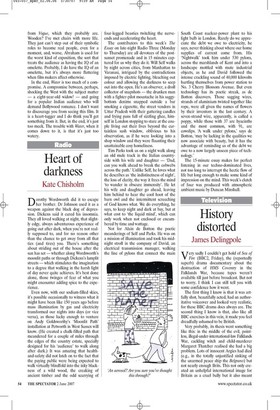Heart of darkness
Kate Chisholm Dorothy Wordsworth did it to escape her brother. Dr Johnson used it as a weapon against the black dog of depression. Dickens said it cured his insomnia. They all loved walking at night, that slightly edgy, always adventurous experience of going out after dark, when you're not really supposed to, and for no reason other than the chance to get away from all that ties (and tires) you. There's something about striding out of the house after the sun has set — whether along Wordsworth's moonlit paths or through Dickens's lamplit streets — which stimulates the imagination to a degree that walking in the harsh light of day never quite achieves. It's best done alone, those twinges of fear of what you might encounter adding spice to the experience.
Even now, with our sodium-filled skies, it's possible occasionally to witness what it might have been like 150 years ago before mass illumination by gas and electricity transformed our nights into days (or vice versa), as those lucky enough to venture on Andy Goldsworthy's 'Moonlit Path' installation at Petworth in West Sussex will know. (He created a chalk-filled path that meandered for a couple of miles through the edges of the country estate, specially designed for his 'audience' to walk along after dark.) It was amazing that healthand-safety did not latch on to the fact that the paying public were being expected to walk virtually blindfold into the inky blackness of a wild wood, the creaking of ancient timber and the odd scurrying of four-legged beasties twitching the nerveends and accelerating the heart.
The contributors to this week's The Essay on late-night Radio Three (Monday to Thursday) are all devotees of the postsunset promenade and in 15 minutes captured for us why they do it. Will Self walks by night across cities, from Manhattan to Varanasi, intrigued by the contradictions imposed by electric lighting, bleaching out colour and allowing the darkness to seep out into the open. He's an observer, a droll collector of snapshots — the drunken man with a fighter-pilot moustache in his saggybottom denims snapped outside a bar smoking a cigarette, the street vendors in Uttar Pradesh with their guttering candles and frying pans full of sizzling ghee, himself in London stopping to stare at the couple living out their lives beyond the curtainless sash window, oblivious to his observation, as if he were looking into a shop window and they were flaunting their unattainable cosy homeliness.
Tim Parks took us on a night walk along an old mule track in the Italian countryside with his wife and daughter — 'Dad, can you walk ahead to break the cobwebs across the path.' Unlike Self, he loves what he describes as 'the indistinctness of night', the loss of clarity, the way it frees the mind 'to wander in obscure immensity'. He let his wife and daughter go ahead, leaving him behind to hear the cool hoot of the barn owl and the intermittent screeching of God knows what. We do everything, he says, to keep night and dark at bay, but at what cost to 'the liquid mind', which can only work when not enclosed or encumbered by time and wattage.
Not for Alain de Botton the poetic meanderings of Self and Parks. He was on a mission of illumination and took his midnight stroll in the company of David, an electrical transmission manager, walking the line of pylons that connect the main South Coast nuclear-power plant to his light bulb in London. Rarely do we appreciate the debt we owe to electricity, he says, never thinking about where our home supplies of current come from. His `Nightwalk' took him under 530 pylons, across the marshlands of Kent and into a landscape mottled with mute industrial objects, as he and David followed the intense crackling sound of 40,000 kilovolts hurtling themselves from power station to No. 3 Cherry Blossom Avenue. But even technology has its poetic streak, as de Botton discovers. Those sagging wires, strands of aluminium twisted together like rope, were all given the names of flowers by their inventors in the last century. A seven-strand wire, apparently, is called a poppy, while those with 37 are hyacinths and the most common, with 91, are cowslips. 'A walk under pylons,' says de Botton, 'may be lacking in the qualities we now associate with beauty, but it has the advantage of reminding us of the debt we owe to a now largely unseen piece of technology.'
The 15-minute essay makes for perfect listening in our techno-dominated lives, not too long to interrupt the hectic flow of life but long enough to make some kind of impression on the mind. This week's clutch of four was produced with atmospheric ambient music by Duncan Minshull.




















































 Previous page
Previous page